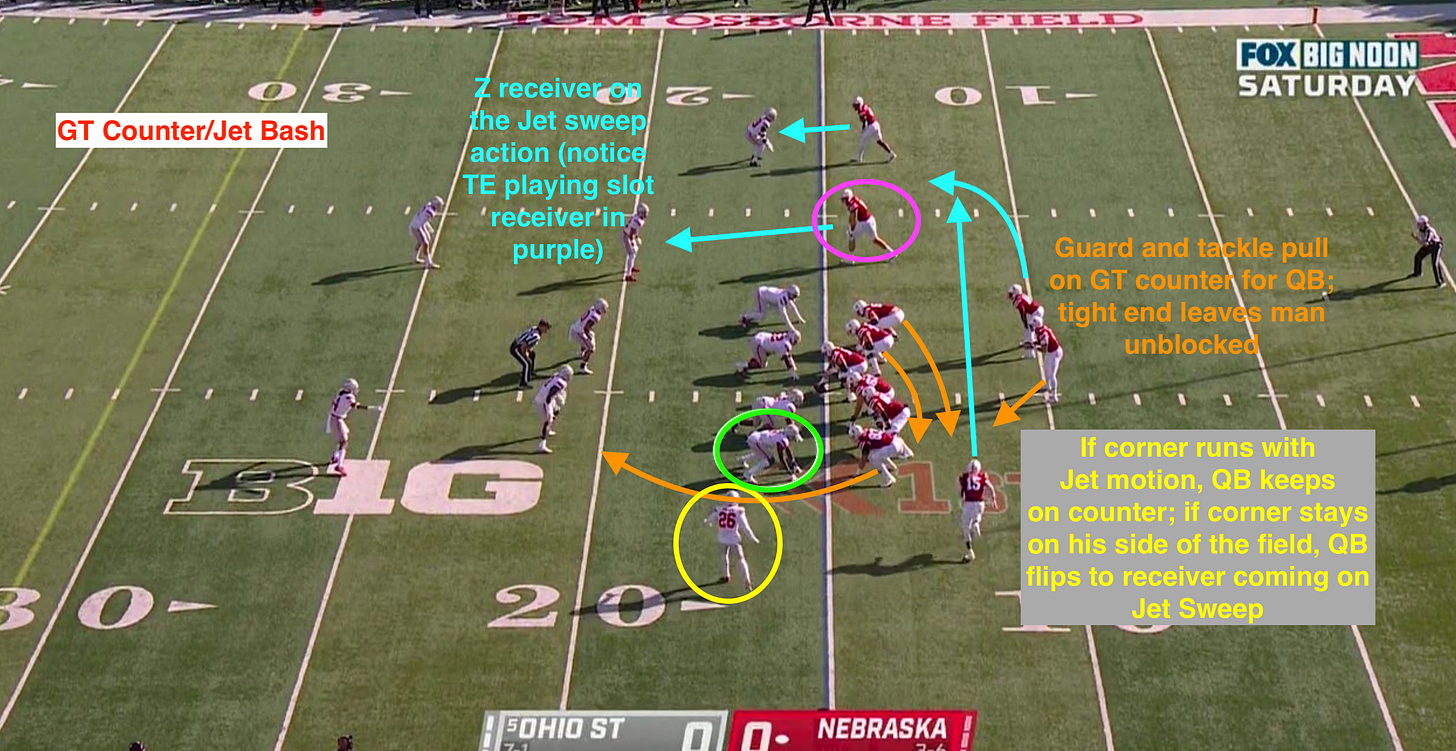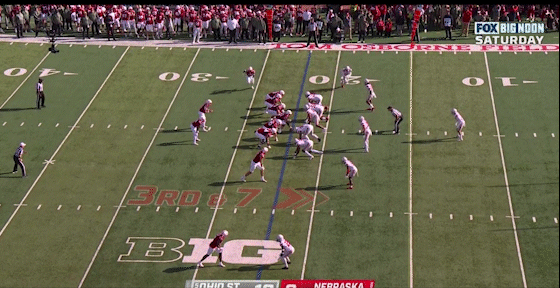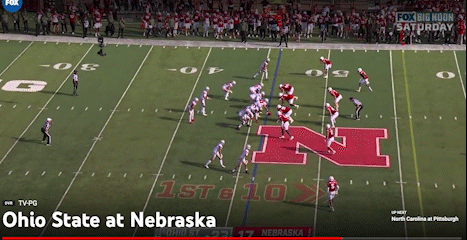OHIO STATE RECAP: Small Margins, Big Changes
Another close loss leads to a massive shakeup for NU's future
For 3.11 seconds (that is accurate; I went back and timed it with a stopwatch) I really thought Nebraska was going to win this game. As I watched the ball bounce and roll lazily on the turf in that amount of time between when Garrett Nelson pawed it out of C.J. Stroud’s hand and when Ohio State center Luke Wypler flopped on it — with it just sitting there ripe to be picked up and run 60-some yards to the end zone in front of 90,000 absolutely berserk fans — I really thought some linebacker or nose tackle was going to swoop in from just off screen and vindicate this entire season of heartbreak.
No one did.
It’s been that kind of season for Nebraska. It’s been the most extreme version of “THAT KIND OF SEASON” for Nebraska. The kind of season where you fire half your assistants with two games left.
I made my case for keeping Scott Frost in the last newsletter; I’m glad the administration made the call they did, and I do think it’s the right one. And I think some fresh eyes at offensive assistants is definitely warranted, though I didn’t expect that much blood to be spilled. I’m not sure how I feel about Frost giving up play calling — I’m never a fan of the, “Have your coach not do the thing they’re best at so they can cosplay being a CEO” move — but that’s maybe a topic for a future (offseason) newsletter.
But whatever’s happened has happened. New directions. Personally, I’m going to try to enjoy the last two games of this season before the we hit the most absolutely insufferable offseason in recorded history.
OFFENSE
OFFENSIVE GAME CHART:
Google Sheet link HERE
Downloadable PDF link HERE
NEBRASKA GAME STATISTICS:
YARDS PER PLAY: 5.91 Yards Per Play
Pregame Season Average: 6.68 yards per play (NCAA rank: 21st)
Postgame Season Average: 6.57 yards per play (NCAA rank: 24th)
National Median: 5.90 yards per play
POINTS PER DRIVE: 1.31 Points Per Drive
Pregame Season Average: 2.35 points per drive (NCAA rank: 61st)
Postgame Season Average: 2.12 points per drive (NCAA rank: 70th)
National Median: 2.21 points per drive
EXPLOSIVE PLAYS: 8 Explosive Play (Pass: 5, Run: 3)
Pregame Season Average: 9.44 explosive plays per game
HAVOC PLAYS ALLOWED: 9 Havoc Plays Allowed (14.75% of plays)
Pregame Season Average: 7.77 Havoc plays allowed per game
NEBRASKA GAME TRENDS:
RUN/PASS: 40.98% Run, 59.02% Pass
TEMPO: 48.84% Slow Tempo, 23.26% Fast Tempo, 23.26% No Tempo, 13.95% Check With Me Tempo
PERSONNEL: 86.66% 11 Personnel, 11.67% 12 Personnel, 1.67% 13 Personnel
FORMATION: 60.00% Trips Formations, 28.33% Doubles Formations, 1.67% Quads Formations, 13.33% Unbalanced Formations, 15.00% Empty Formations, 1.66% Two-Back Formations
MOTION: Motion on 61.67% of Plays
PASS DATA (Percentage out of pass plays only): 45.71% Play Action Percentage, 62.86% 3 Step Percentage, 17.14% Boot/Rollout, 5.71% Screen Percentage
PASS PROTECTION (Percentage out of pass plays only): 54.29% 5-Man Protections, 14.29% 6-Man Protections, 8.57% 7-Man Protections
ELEMENTS: 23.33% Triple Option Percentage, 10.00% RPO Percentage, 56.00% Run Read Percentage
OVERVIEW:
Nebraska’s offensive success this year has been predicated on being able to run the ball effectively to stay on schedule, then hitting explosive plays off deep crossers or scrambles when teams start packing the box or playing single-high coverage structures. But Ohio State’s defensive line completely dominated the running attack Saturday, forcing NU to play one handed. The Huskers was able to hit a few successful runs when using misdirection concepts like their triple option and counter plays, but the rest of their run concepts were all D.O.A. — the 13 triple option and counter plays run Saturday averaged 6 yards per carry, the other 21 runs averaged 1.66 yards per carry. Without being able to trust their run game to get consistent yardage, the Huskers had to start airing it out — not really how they want to play — and finished the game with a season-high 60/40 pass-to-run ratio.
When an opposing defense knows you have to throw the ball, either in disadvantageous third downs — which NU found itself in a lot Saturday — or because you can’t run the ball, there’s nothing to keep it thinking or cautious or at home, and it’s able to go full-out on rushing the passer. That’s a big problem when you have two of the worst pass-blocking tackles in the conference. Bryce Benhart and Turner Corcoran gave up a combined 12 of NU’s 16 total pass rush pressures per PFF on Saturday and looked completely ineffective when they weren’t given help via chip or running back/tight end assistance. Their poor play hurts your offense in very obvious ways, but it also hurts you from a resource allocation perspective. You can help your tackles out with those chips/extra blockers/rollouts/etc. every so often, and the NU coaches did, but you can’t do it EVERY play without the defense keying in and blitzing more, and allocating more resources to pass protection means fewer guys out running routes, something that’s especially important against more talented defenses that are able to lock up receivers one-on-one (like OSU). Those guys who are staying in to protect are the guys you’d like to have running check downs or intermediate routes to give your quarterback more passing options. Think about all the snaps Saturday where Adrian Martinez was staring downfield at a passing concept with only three receivers out in routes downfield who were all well-covered; those incompletions or sacks being transformed into 5-yard completions to Rahmir Johnson or Austin Allen is maybe the difference in the game. There are always going to be times you keep more guys in to load up and take a shot, and NU still ran five-man protections on over half its passing snaps, but if you want to talk about tangible ways to improve this offense, getting two tackles who can block Big Ten defensive ends is about the most impactful thing that could happen. Certainly more than getting a new quarterback.
One thing I didn’t quite get was the Husker staff not turning to more quick-hitting passing concepts or utilizing Martinez’s legs more. OSU ran more man coverage than any NU opponent this year — on over 58% of its total defensive snaps — and more underneath passing concepts or a quarterback using his legs are good answers to that. I’ve talked about Martinez’s struggles with quick-game in past newsletters, so maybe the staff is just completely done with trying to run it with him. But even on the deeper passing concepts, it looked as if he had lanes to scramble and didn’t, and on a lot of the run plays, the edge looked ripe for the QB to pull the ball and take it for a nice gain. The Buckeyes did spy Martinez in obvious passing downs, and he’s obviously banged up in some way, but the biggest plays in the second half were all 2AM using his legs. It feels like a missed opportunity to not have gone to some of that sooner.
The staff did have some nice answers against Ohio State’s Cover 1 in the deep passing game when the line allowed time to throw. Samori Toure’s long touchdown came on a beautiful/diabolical play design with a lot of moving parts that NU executed really well:
2nd and 7: Gun Doubles Y Wing WR Stack Strong — Double Posts
Nebraska knew pre-snap OSU was likely to be in Cover 1 (because of the press alignment of the corners and the deep positioning of the single-high safety) and probably checked into this play off the sideline after seeing this structure. Cover 1 means the two corners are locked on to their receivers in man coverage and the single safety is responsible for putting a top on the entire field.
Having the receivers “stacked,” or lined up vertically behind each other, gives the thinner Toure a free release off the line of scrimmage against Ohio State’s press man coverage. At the snap, Martinez gives a run fake to Johnson, pulling the two linebackers forward, and then half rolls to the field, further pulling them away from the two receivers the concept is intended for. Omar Manning (green in the diagram below), the “X” receiver and a bigger body able to handle press well, fights inside, taking his man defender with him, before getting upfield and occupying the safety. That leaves Toure one-on-one with his man defender on the backside of the play with no traffic. He runs a great little short post route and sneaks in behind the safety, who’s focused on the initial crossing route from Manning.
Seeing them execute pretty clockwork stuff like this against an excellent defense gives me faith this offense is not far away. People sometimes like to be pretend the offense is a disaster or a major problem or “not trusted on a fourth down” or whatever — it’s not. This thing needs tweaks and two tackle upgrades, not a demolition job.
Some final offensive notes, NU ran more empty looks than it has in any game this season — something that is hard on an offensive line, as the defense knows before the snap you are going to be in a five-man protection — and used quite a bit more unbalanced formations and RPOs than it has in recent games. This gameplan kind of resembled the version of the offense we were seeing at the end of last season — the more Oregon/UCF version of the offense — as opposed to the triple-option heavy attack they’ve been using since conference play began. One explanation might be that they didn’t trust lining up and running on OSU the way they had against other teams and wanted to spread things out more. But with two excellent defenses in Wisconsin and Iowa in the season’s last two games, we might be seeing this style a bit more.
A COOL PLAY:
I’ve talked in previous newsletters about Nebraska’s use of a “Bash” concept, a running play that inverts the read option relationship: The primary design of the play is for a quarterback run, while the running back takes over the secondary “pull” element if the defense overcommits. NU showed a tricky new variation against OSU without the running back, using a Jet Sweep action:
1st and 16: Gun Doubles WR Flex Weak Z Jet — GT Counter/Jet Bash
The primary option for this play is for the quarterback to keep it on a counter run behind the pulling backside guard and tackle (GT Counter) to the bottom of the diagram. But NU reads the corner lined up over the Z receiver running the Jet motion; if he stays home instead of running across the formation with the presnap Jet motion (as in the above clip), the QB has the option to flip the ball to the receiver on the Jet Sweep action. If he runs with the motion across the formation (as he does in the next clip), the QB keeps on the counter. Either way, NU has a blockers/numbers advantage for whichever play they run.
Another element here is that NU is actually playing with two tight ends, even though it’s in a spread formation; tight end Allen is playing slot receiver in the purple circle to give the Huskers a blocking edge. That’s a smart deployment of personnel. NU ran this again later in the game on the play everyone was mad about Martinez running after the ankle tweak. Here’s what it looks like when the quarterback keeps:
3rd and 7: Gun Doubles WR Flex Weak Jet — GT Counter/Jet Bash
Some might not call this a “Bash” concept since the two elements are equal and the read comes presnap, but considering how much NU likes Bash I think these are probably in the same family.
DEFENSE
DEFENSIVE GAME CHART:
Google Sheet link HERE
Downloadable PDF link HERE
GAME STATISTICS:
YARDS PER PLAY ALLOWED: 5.89 Yards Allowed Per Play Allowed
Pregame Season Average: 4.97 yards allowed per play (NCAA rank: 22nd)
Postgame Season Average: 5.08 yards allowed per play (NCAA rank: 34th)
National Median: 5.56 yards allowed per play
POINTS PER DRIVE ALLOWED: 1.73 Points Allowed Per Drive
Pregame Season Average: 1.71 points allowed per drive (NCAA rank: 24th)
Postgame Season Average: 1.73 points allowed per drive (NCAA rank: 26th)
National Median: 2.20 points allowed per drive
HAVOC PLAYS: 11 Havoc Plays (13.10% of plays)
Pregame Season Average: 10.66 Havoc plays per game
EXPLOSIVE PLAYS ALLOWED: 9 Explosive Plays Allowed (Pass: 8, Run: 1)
Pregame Season Average: 5.55 explosive plays allowed per game
GAME TRENDS:
NEBRASKA GAME TRENDS:
RUN/PASS: 69.05% Pass, 30.95% Run
PERSONNEL: 84.53% 2-5 Nickel, 4.76% Base, 9.52% Dime, 1.19% 4-4
FRONT: 79.51% Even Front, 20.49% Odd Front, 9.52% Pressure Package
BOX NUMBERS: 67.86% Standard Box, 13.09% Heavy Box, 19.05% Light Box
SECONDARY STRUCTURE: 55.95% 2-High Safeties, 41.67% 1-High Safeties, 1.19% 0-High Safeties, 1.19% 3-High Safeties
PASS RUSH: 61.91% Standard Rush, 34.52% Blitz, 3.57% Light Rush
COVERAGE: 33.33% Cover 3, 28.57% Cover 1, 16.66% Cover 4, 7.14% Cover 6, 1.19% Cover 0, 0.00% Cover 2
OVERVIEW:
Ohio State has the best collection of skill talent in the country. It entered averaging over EIGHT YARDS per play. NU did catch a break when Garrett Wilson didn’t play, but the Blackshirts holding OSU down the way they did was a phenomenal effort.
Nebraska did it by throwing some curveballs. NU almost never blitzed entering this game, then brought heat 3 out of the first 4 plays Saturday and on a season-high 34.52% of its snaps. It played almost as much Cover 1 man coverage than it did Cover 3. It played Dime personnel — something it’s run a handful of times in total this season in very specific situations — more than it played its Base 3-4 defense. It was a pretty counterintuitive gameplan from Erik Chinander, and it felt as if it kept OSU just off-balance enough to keep it from breaking the game open.
Converting pressures into sacks/Havoc and tackling have been struggles for this defense this year and were again Saturday. NU got 17 pressures on a very good OSU offensive line — not counting quite a few UNCALLED HOLDS — but just 1 sack and missed some tackles in key situations. I’m not putting any atom of fault on the defense for this one, but actually cashing in some of those pressures was another way the outcome of this game could have changed.
Enough can’t be said about JoJo Domann, who had season-ending surgery and played his last game as a Husker on Saturday. He went out on his masterpiece. He played 59 snaps out of the box covering OSU receivers and allowed just 18 receiving yards on 7 targets with two pass breakups and another interception, didn’t miss a single tackle attempt and had a pass rush pressure. KING. I said on Twitter he’s the best Blackshirt since Lavonte David; I’m not kidding. This dude is gonna play in the NFL for 10 years as a nickelback/tight end stopper guy. One of my favorite Huskers in a long time.
One last defensive note is the number of light boxes OSU faced and perplexingly … didn’t run into them. The Buckeyes were spreading NU out with open shotgun formations, and NU was obliging by pulling defenders out of the box. Much as with the OU game, it felt as if OSU could have run for 5 yards per carry and left the stadium with a couple-touchdown win if it wanted but couldn’t help itself from being greedy.
HOW SMITH-NJIGBA ROASTED NU’S SECONDARY:
Jaxon Smith-Njigba broke the single-game Ohio State record Saturday with 15 catches, which also went for 240 yards. He did gain about a third of that yardage on one 75-yard catch — which was not Quinton Newsome’s fault by the way; he was the deep 1/3 defender in Cover 3 and Smith-Njigba’s short route was the responsibility of safety Marquel Dismuke. Usually when someone gets 240 yards on you, it’s because they hit a couple monster bombs. But Smith-Njigba average depth of target was only 7.6 yards; his routes weren’t really coming down the field at all; he mostly just did this by tormenting NU linebackers and safeties over the middle out of the slot. He was especially effective on run-pass options over the middle against Cover 3 and Cover 4:
1st and 10: Base Defense — Under 4-2 Even Cover 3 Robber
This rep actually goes to Chris Olave, but the concept here is the same and Smith-Njigba ran most of them in the game. Ohio State runs a split zone running play here, and the quarterback pulls the ball if they see the defense fly to the run. Nebraska is in Cover 3, meaning its linebackers are responsible for middle of the field coverage. Like in the play above, too often Saturday they flew to the ball on any run look, leaving little curl/hook routes open for easy throws:
Ohio State killed Nebraska with this specific play. I counted at least three times OSU ran it for 10 or more yards in the second half. Here’s another:
OSU also had a lot of success with other RPOs, especially ones with running elements using multiple pulling offensive linemen like Buck Sweep. On RPO passing plays where Stroud pulled the ball and threw, he was 7 for 8 and averaged 11.4 yards per completion. Minnesota had a lot of success with a similar attack vs. NU; opposing teams are starting to notice that the Blackshirt linebacker bite awfully hard on pulling linemen. GBR














